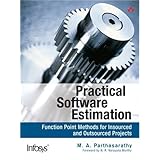
Average Reviews:

(More customer reviews)Much of the book is devoted to explaining the Function Point method for estimating the size of a software package that has yet to be written. The basic problem is that software is so intangible compared to designing hardware. Which makes it hard to define objective metrics. But the author suggests that finding the function points of a software package is the best approach. He also points out a key distinction between the size and the effort needed to write the package. The effort is essentially the number of person months. If you can get a reliable estimate of the size, then estimating the effort should be easier.
While the book gives detailed explanations of how to find the function points, there is still an inherent subjectivity. Minimised mainly through experience. You need to work on several projects and apply the method. The strongest point in favour of function points could be that it is independent of how the software is written.
To an American reader, a major interesting aspect of the book is its take on insourcing versus outsourcing. The author is a top executive at Infosys, one of the largest Indian outsourcing firms. You should look at chapter 11, which debates this issue. A commendably balanced treatment, giving tables that clearly lay out the pros and cons of either approach. There is no bias towards going with outsourcing.
Click Here to see more reviews about: Practical Software Estimation: Function Point Methods for Insourced and Outsourced Projects
Product Description:
"A clearly written book that is a useful primer for a very complicated set of topics." --Capers Jones, Chief Scientist Emeritus, Software Productivity Research LLCPractical Software Estimationbrings together today's most valuable tips, techniques, and bestpractices for accurately estimating software project efforts, costs,and schedules. Written by a leading expert in the field, it addressesthe full spectrum of real-world challenges faced by those who mustdevelop reliable estimates. M. A.Parthasarathy draws on the immense experience of Infosys, one of theworld's largest and most respected providers of IT-enabled businesssolutions, to bring you the only book with detailed guidance onestimating insourced and outsourced software projects, as well asprojects that blend both approaches. He demonstrates how tosuccessfully utilize Function Point (FP) methods, the industry'sleading estimation model. Then, using real case studies, hesystematically identifies pitfalls that can lead to inaccurateestimates--and offers proven solutions. Coverage includes
How to estimate all types of software projects, including "fresh" development, reengineering, and maintenance
How to incorporate the impact of core project elements on estimates: scope, environment, experience, and tools
FP analysis from start to finish: data and transaction functions, general system characteristics, and more
FP methods for any platform or business function
Innovative re-estimation methods to track progress
How to quote RFPs and prepare contracts: fixed price, time/material, and project execution lifecycle models
Alternatives to FP: Delphi, COCOMO II, and COSMIC-FFP
How to choose the right estimation tools
Practical Software Estimationis the definitive reference for anyone who must estimate softwareprojects accurately: project and IT managers, individual developers,system designers, architects, executives, consultants, and outsourcersalike.
List of Figures
List of Tables
Foreword
Preface
Acknowledgments
Chapter 1: Introduction
Chapter 2: Role of Estimation in Software Projects
Chapter 3: A Study of Function Point Analysis
Chapter 4: Data Functions
Chapter 5: Transactional Functions
Chapter 6: General System Characteristics
Chapter 7: Size, Effort, and Scheduling of Projects
Chapter 8: Estimation Flavors
Chapter 9: A Sense of Where You Are
Chapter 10: Tips, Tricks, and Traps
Chapter 11: Insourcing versus Outsourcing
Chapter 12: Key Factors in Software Contracts
Chapter 13: Project Estimation and Costing
Chapter 14: Other Estimation Methods
Chapter 15: Estimation Tools
Chapter 16: Estimation Case Study
Appendix A: Reference Tables: Transaction Function Counts
Appendix B: Reference Tables: Data Function Points
Bibliography
Index
Want to read more honest consumer review about Practical Software Estimation: Function Point Methods for Insourced and Outsourced Projects now ?

0 comments:
Post a Comment